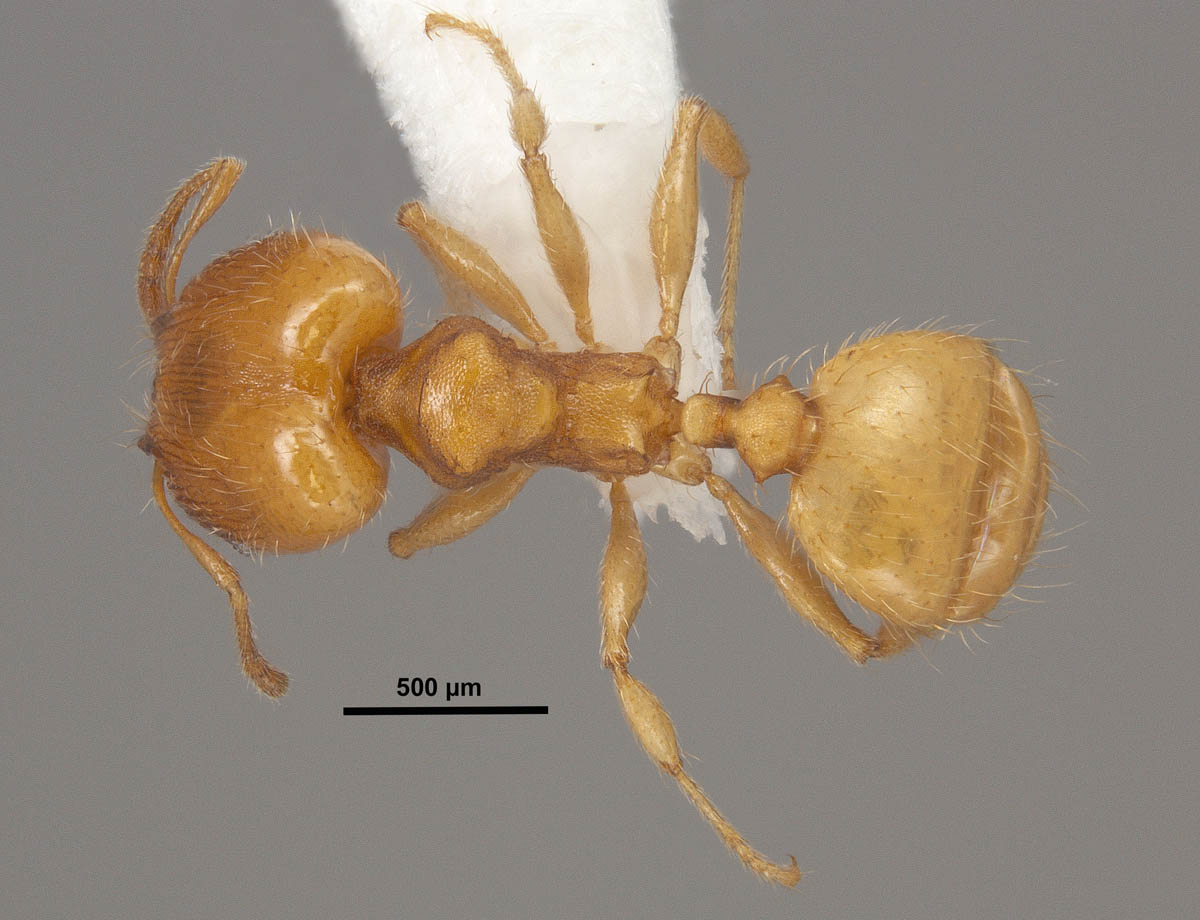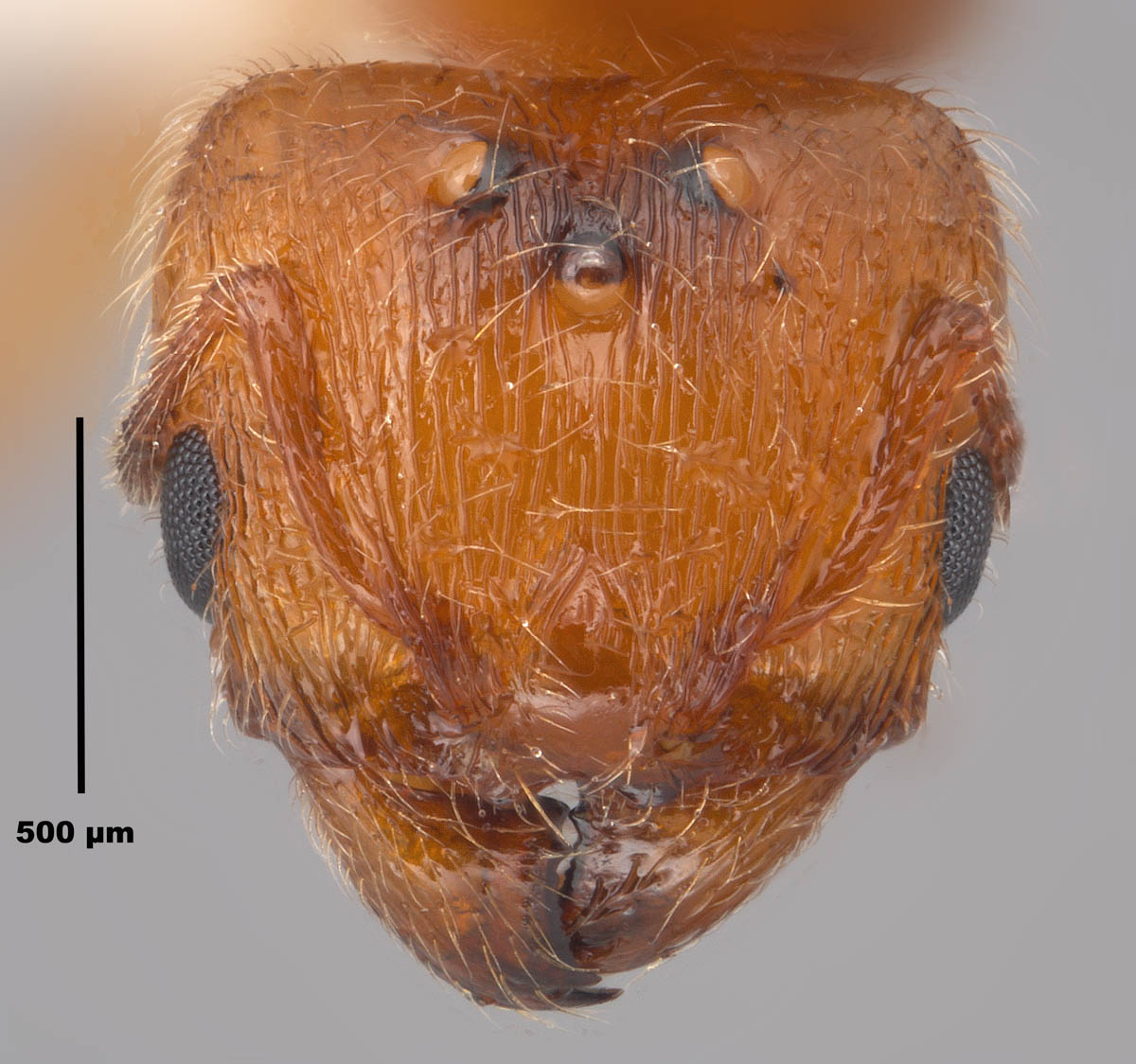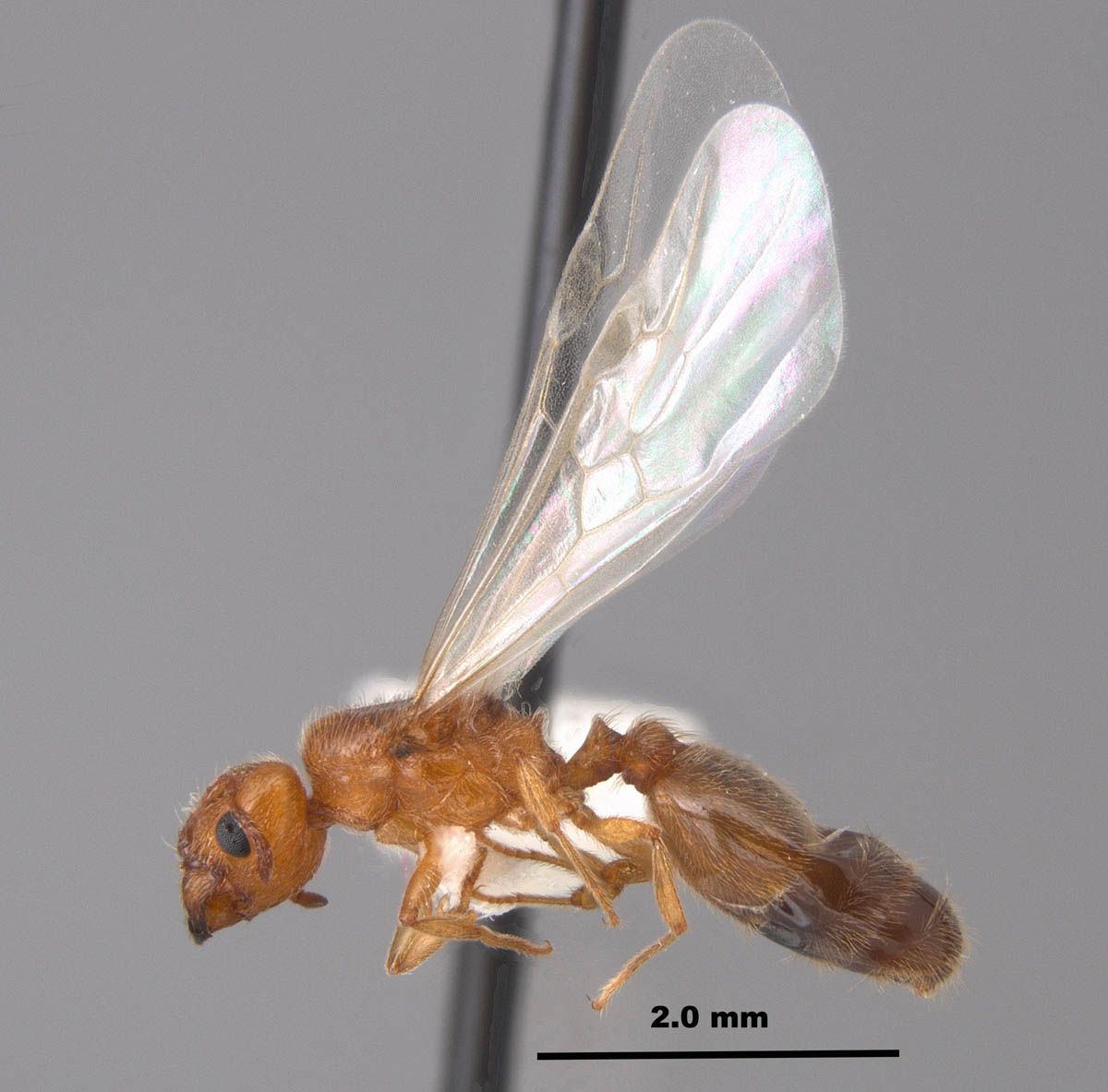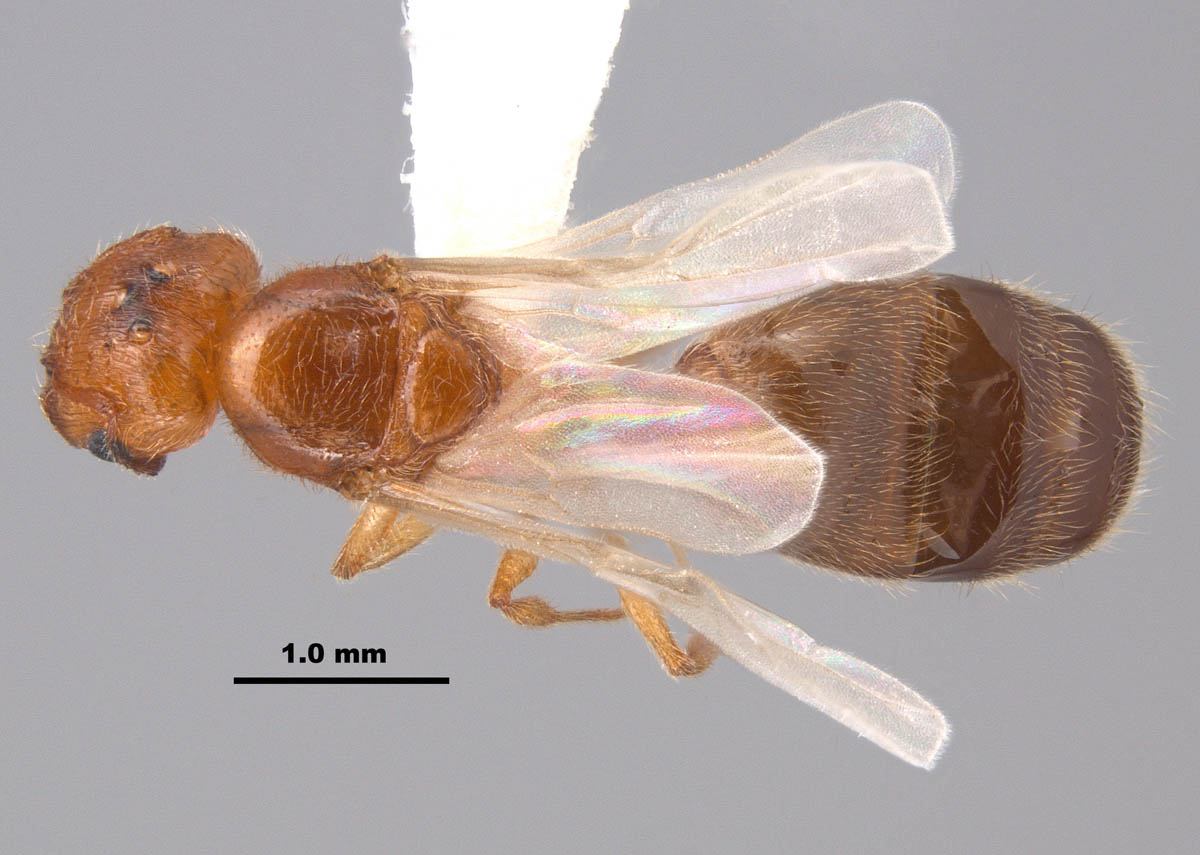Introduction
The genus Pheidole has been described as 'hyperdiverse" by Wilson (2003) in large part by the abundance and diversity of the genus, especially in the Neotropics. Workers in this genus have discrete major and minor castes, with the major workers having greatly enlarged heads. In the southeastern US, 21 named species are known to occur and at least one undescribed species is known from the region. In the Southeast, members of this genus can be found in all terrestrial habitats from fine sandy localities bordering creeks to hard-pan dirt in open area beside roadways to inside rotting wood in natural forested habitats. Both major and minor workers have 12-merous antennae (including scape and pedicel) that terminates in a 3-merous club; waist with both petiole and postpetiole, and atrophied sting. Many species possess propodeal spines, although a few do not. Majors are distinctive with their hugely enlarged heads (proportional to the body), which may be as wide or as long as the mesosomal length, and by the large mostly edentate mandible. Minor workers are much smaller than majors and often have dramatic physical differences. Queens are similar to major workers, except the heads are not proportionally enlarged as compared to the body, eyes are proportionally larger to the head than with workers, ocelli are present, overall are typically larger than both minor and major workers, and have enlarged thoracic regions to accommodate wings. Males are quite different in appearance from both workers and queens being somewhat wasp-like with beaded 13-merous antennae, greatly enlarged eyes (eye length may be half of more of the head length), reduced mandibles, enlarged ocelli that bulge from posterior margin of head, and with proportionally large wings.
According to Sarnat et al. (2015), most of the specimens identified as P. floridana from the southeastern United are actually Pheidole bilimeki Mayr. These authors imply that perhaps P. floridana should even be synonymized with P. bilimeki in the future, but note that specimens that closely match P. floridana are known from the Miaimi, Florida region. According to Sarnat et al. (2015), majors of P. bilimeki differ from P. floridana by the first gastral tergite being matte, rather than shiny. I'm not sure if this character will hold up, but regardless, P. bilimeki, being the older name, would have priority. Thus, here I follow the concept proposed by Sarnat et al. (2015) until such a time when we have new information.
Taxonomic History (Bolton 2016)
Pheidole bilimeki Mayr, 1870: 985 (s.q.) MEXICO. Neotropic. "Bilimek." NMW. Senior synonym of Pheidole punctatissima annectens, Pheidole floridana antoniensis, Pheidole floridana ares, Pheidole anastasii cellarum, Pheidole floridana deplanata, Pheidole punctatissima insulana, Pheidole anastasii johnsoni, Pheidole anastasii venezuelana: Wilson, 2003: 378; of Pheidole rectiluma: Longino, 2009: 16; of Pheidole lauta: Sarnat, Fischer, Guénard & Economo, 2015: 35.
Identification (from Longino and Cox (2009))
Minor worker: head width (not including eyes) 0.38 to 0.55mm; scape length 0.40 to 0.60mm; scape index (100 * scape length / head width) 95 to 125; face and mesosoma uniformly foveolate; promesonotal groove very weakly or not at all impressed; with short upturned propodeal spines; postpetiole broad and low, somewhat flattened, lower than petiolar node; first gastral tergite with anterior third to entire surface shagreened; pilosity on mesosomal dorsum sparse and stiff; pilosity on hind tibia fully appressed and short.
Major worker: head width 0.74 to 1.09mm; scape length 0.44 to 0.63mm; scape index 50 to 68; face largely foveolate rugose, with variable extent smooth and shiny posteriorly; hypostomal margin with two closely-spaced medial teeth; first gastral tergite with anterior third to entire surface shagreened.
Biology and Economic Importance
The following paragraph is from Longino and Cox (2009): "Pheidole bilimeki is a common species in open, recently or frequently disturbed habitats. It occurs in all tropical climate zones where ants occur: lowland dry forest, lowland wet forest, and montane habitats to about 1500m elevation. In Costa Rica it is a common ant of roadsides, nesting under stones or in dead fenceposts. It is a frequent pest ant in houses. It is a common ant at baits in second growth dry forest vegetation in seasonally dry Guanacaste Province. It can also be abundant in large disturbances deep within primary forest reserves. The Peñas Blancas Valley is a large forested reserve in the Cordillera de Tilarán in northern Costa Rica. In 2001 there was a large debris torrent that created a very large area currently undergoing primary succession. The area is about 5km from the edge of the reserve and human settlement. As of early 2008 the area was dominated by P. bilimeki."
In the southeastern United States, P. bilimeki, previously reported as P. floridana, appears to be restircted to the extreme southern portion of the Coastal Plain where it almost alway is found nexting in sandy soils.
Acknowledgments
Funding for the ant work being done by the MEM in Alabama and Mississippi is from several sources including the National Institute of Food and Agriculture, United States Department of Agriculture, under Project No. MIS-012040, the Mississippi Agricultural and Forestry Experiment Station at Mississippi State University, with support from State Project MIS-311080, NSF Grants BSR-9024810 and DFB-9200856, the Tombigbee National Forest (U.S. Forest Service), the Noxubee Wildlife Refuge, Mississippi Natural Heritage Program Research Grant, USDA Forest Service Agreement No. 08-99-07-CCS-010, the William H. Cross Expedition Fund, and primarily by the USDA-ARS Areawide Management of Imported Fire Ant Project. Additionally, special cooperation has been provided by State Parks, National Forests, National Wildlife Refuges, the Natchez Trace Parkway, and from various private landowners in both Alabama and Mississippi.
Literature Cited
Bolton, B. 2016. Bolton World Catalog Ants. Available online: http://www.antweb.org/world.jsp. Accessed 26 October 2016.
Longino, J. T. and D. J. Cox. 2009. Pheidole bilimeki reconsidered (Hymenoptera: Formicidae). Zootaxa. 1985:34-42.
Mayr, G. 1870. Neue Formiciden. Verh. K-K. Zool.-Bot. Ges. Wien 20: 939-996 (page 985, soldier, queen described)
Sarnat, E. M., G. Fischer, B. Guenard, and E. P. Economo. 2015. Introduced Pheidole of the world: taxonomy, biology and distribution. Zookeys. 1-109. doi:10.3897/zookeys.543.6050
Wilson, E. O. 2003. Pheidole in the New World: A dominant, hyperdiverse ant genus. Harvard University Press, Cambridge, MA.
Links
Antweb
Antcat
Antwiki
|












